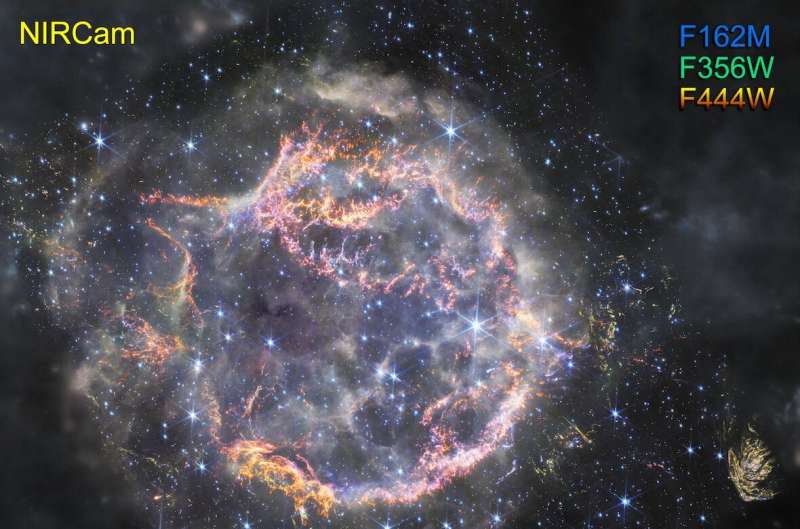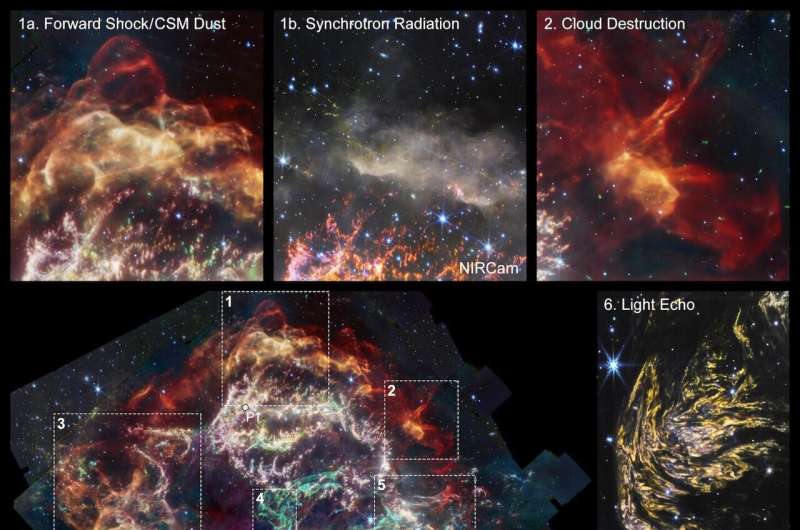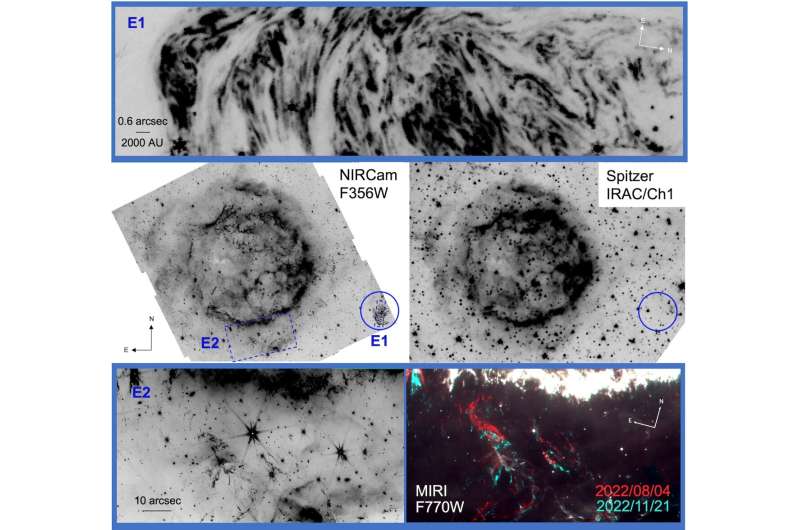This article has been reviewed according to Science X's editorial process and policies. Editors have highlighted the following attributes while ensuring the content's credibility:
fact-checked
peer-reviewed publication
trusted source
proofread
NASA telescopes chase down 'Green Monster' in star's debris

By bringing together data from two NASA telescopes, astronomers may have solved a mystery around a bizarre structure found in the debris field of an exploded star. Their work has uncovered new details about the star's remains, and about the explosion itself.
This study of the well-known supernova remnant Cassiopeia A (Cas A) uses data from the Chandra X-ray Observatory and James Webb Space Telescope and includes the first image of Cas A combining data from both telescopes.
The curious structure was first identified in Webb's infrared data from April 2023. The origin of this feature, dubbed the "Green Monster" because of its resemblance to the wall in the left field of Fenway Park, was not clear.
However, by combining the Webb data with X-rays from Chandra, researchers think they have hunted down the source of the Green Monster.
"We already suspected the Green Monster was created by a blast wave from the exploded star slamming into material surrounding it," said Jacco Vink of the University of Amsterdam, who leads the Chandra work. "Chandra helped us clinch the case."
When a massive star exploded to create Cas A about 340 years ago, from Earth's perspective, it created a ball of matter and light that expanded outward. In the outer parts of Cas A the blast wave is striking surrounding gas that was ejected by the star between about 10,000 and 100,000 years before the explosion. That formed a favorable environment for dust formation after the ejected stellar material cooled down.
The Chandra data reveals hot gas, mostly from supernova debris including elements like silicon and iron, but also from energetic electrons spiraling around magnetic field lines in the blast wave. These electrons light up as thin arcs near the blast wave, and also show up in parts of the interior. Webb highlights infrared emission from dust that is warmed up because it is embedded in the hot gas seen by Chandra, and from much cooler supernova debris.
Despite this chaotic stellar scene, the Green Monster clearly stood out in the original Webb image. While analyzing Chandra data of the remnant, Vink and his colleagues found that filaments in the outer part of Cas A, from the blast wave, closely matched the X-ray properties of the Green Monster, including less iron and silicon than in the supernova debris. This implies a common origin for the Green Monster and blast wave.
The Chandra data also shows that the material in the Green Monster is all moving towards us, indicating that it is plowing into the star's ejected gas on the near side of Cas A. Its speed is about half the average speed of the blast wave, suggesting that the density of material in the Green Monster is much higher than the average density of material surrounding Cas A. This result can help reconstruct the complicated history of mass lost by the star before it exploded.
"We concluded that the Green Monster is also part of the blast wave and is photobombing the central part of Cas A rather than being part of it. We then digitally removed the Green Monster from the rest of the image to learn more about what is behind it," said Ilse De Looze from Ghent University in Belgium, who is a co-investigator of the Webb study. "It's like we were handed a completed, 3D jigsaw puzzle, and we were able to take parts out to see what's on the inside."

The debris from the star is seen by Chandra because it is heated to tens of millions of degrees by shock waves, akin to sonic booms from a supersonic plane. Webb can see some material that has not been affected by shock waves, what can be called "pristine" debris. Much of this lies behind the Green Monster. The combination of Webb and Chandra data therefore gives a fuller census of debris from the exploded star.
"We've made the first map of the web-shaped, pristine debris in the center of this supernova remnant," said Dan Milisavljevic from Purdue University, who is leading the Webb study and presented these results at the 243rd meeting of the American Astronomical Society in New Orleans. "No one has ever seen structures like this before in an exploded star."
To learn more about the supernova explosion, the team compared the Webb view of the destroyed star's pristine debris with X-ray maps of radioactive elements that were created in the supernova. They used NASA's NuSTAR (Nuclear Spectroscopic Telescope Array) data to map radioactive titanium—still visible today—and Chandra to map where radioactive nickel was by measuring the locations of iron. Radioactive nickel decays to form iron.
Two aspects stood out in this comparison. Some filaments of pristine debris near the center of Cas A, seen with Webb, are connected to the iron seen with Chandra farther out. Radioactive titanium is seen where pristine debris is relatively weak.

These comparisons suggest that radioactive material seen in X-rays has helped shape the pristine debris near the center of the remnant seen with Webb, forming cavities. The fine structures in the pristine debris were most likely formed when the star's inner layers were violently mixed with hot, radioactive matter produced during collapse of the star's core under gravity.
"These Webb survey data and initial findings, supported by other telescopes like Chandra, help address unresolved questions about massive star explosions that have broad implications for the formation and evolution of stellar populations, and the metal and dust enrichment of galaxies," said Tea Temim of Princeton University, who is a co-investigator of the Webb study.
These results are described in two papers submitted to Astrophysical Journal Letters, one led by Dan Milisavljevic focused on the Webb results (preprint here) and the other led by Jacco Vink focused on the Chandra results (preprint here). Related papers by other members of the research team are also in preparation.
More information: Dan Milisavljevic et al, A JWST Survey of the Supernova Remnant Cassiopeia A, arXiv (2024). DOI: 10.48550/arxiv.2401.02477
Jacco Vink et al, X-ray diagnostics of Cassiopeia A's "Green Monster": evidence for dense shocked circumstellar plasma, arXiv (2024). DOI: 10.48550/arxiv.2401.02491
Journal information: arXiv , Astrophysical Journal Letters
Provided by Chandra X-ray Center




















